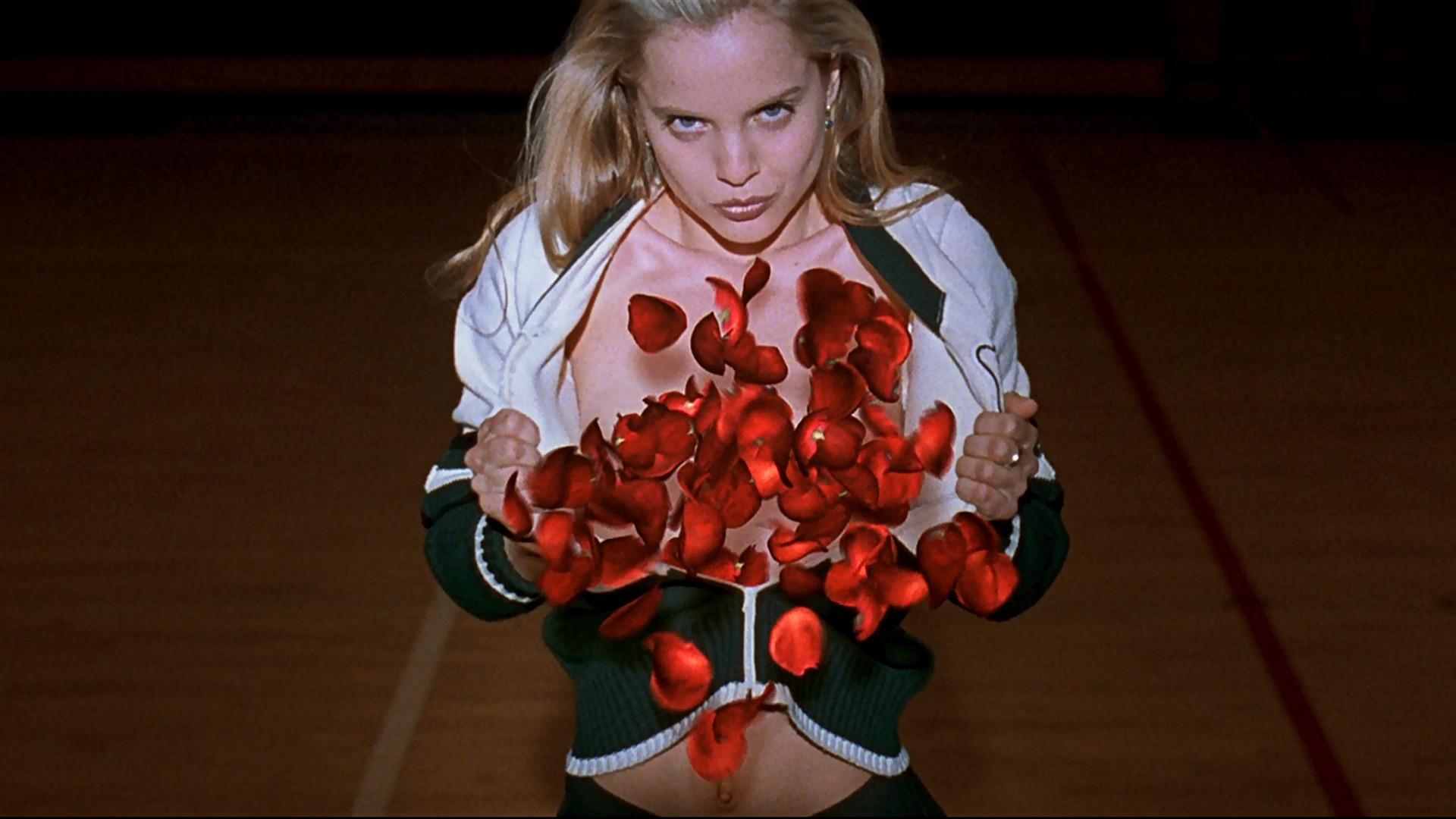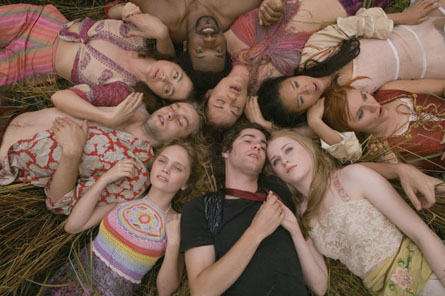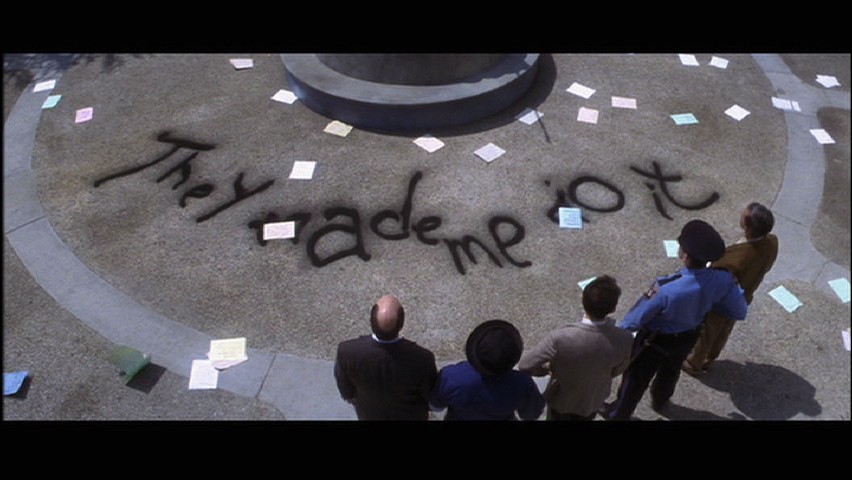In the 1990 film American Beauty directed by Sam Mendez, the just-below-average, coward suburban father lusts over his daughter's best friend, but really just the concept of being in touch with his youth again, ultimately coming to his end as he finally find himself and finds beauty within those that truly matter. When Lester first lay eyes on Angela during his daughter Jane's dance team performance, the director sets the scene in an anticipatory set up, tilting the shot in a smooth, upward motion and the entire dance team flares out to reveal princess-like Angela in the center. The shot begins to slowly zoom in on her from a long shot to a medium closed shot; emphasizing her significance later on in the film and as the shot is zoomed more and more upon her, it's literally Lester's attraction to her as he becomes more focused on her, zoning out everything else within the shot just as zooming in on her cuts out the distractions in the scene with her. The music in the gymnasium also fades from the upbeat and innocent dance music to a tense, off key, and atonal chime as the the crosscut close ups showing Lester's first fantasy about Angela, watching her dance seductively and winking at him; in intend to make the audience incredibly uncomfortable. As Lester has more interactions with Angela, some real and some only in his head; in finding sparks of youth through Angela, he finds a new joy in life in trying to relive his younger years and preserving those feelings. Lester speaks as a non diegetic voice over in an ariel establishing shot of the neighborhood, his house, and then himself running out the door saying "Remember those posters that said, "Today is the first day of the rest of your life"? Well, that's true of every day but one - the day you die." with The Seeker by The Who also playing in the background. This foreshadows his ultimate fate of dying in search of himself, the lyrics of The Seeker “I’m looking for me. You’re looking for you. They call me the Seeker. I’ve been searching low and high. I won’t get to get what I’m after. Till the day I die." also signifies his death in that he isn't actually in love with Angela, but rather the thrill he feels. The running Lester is completely unaware of the non-diegetic sounds and his only concern of the moment is to have a good work out to look hot for Angela. Through out the film, the use of color and lighting strongly help support Lester's internal emotions. The roses can be seen in nearly every shot, being the high contrast of the only bright warm tones in shot of bland cool tones, although the roses are planted by his wife, he only associates them with Angela; only in the last scene, seconds before his death does the associate them with his family for the first time. The high key lighting of his face is also in contrast with the low key lighting of his face from the beginning of the film, suggesting the positive effects of his search for self but also getting closer to the "light at the end of the tunnel" in which his face is fully lit in a soft but bright light. The soft piano music used at the scene of his death is used as characterization in that it's also played during the plastic bag scene when Ricky talks about there's beauty within everything, he finally found the real beauty in his life even though he's dead; he died happy and beautifully. In watching this film, the audience goes from being incredibly uncomfortable and awkward to shocked by the bullet that went through Lester's head; through a series of up and downs on the emotional roller coaster ride, they are in the end at peace and mournful for Lester; released of the anger and bitterness to truly appreciate the beauty with in life.
Almost Famous by Cameron Crowe is a 2000 film that tells Crowe's experience in his teenage years through the story of 15 year old William Miller and his journey of finding his way through the world of sex, drugs, and rock n' roll. When William's sister leaves to become a stewardess, she tells William to look under his bed for a bag of records; it then cuts to a medium ariel shot of William finding the records and a note Anita left for him to "Listen to Tommy with a candle lit, it will change your entire future." suggesting as if Anita or God is watching from above, that it's all in his destiny to find his way in rock n' roll and music. The scene then cuts to William playing Tommy on the record player and the shot slowly dissolves in to William lighting the candle, and by the end of the song, William is a 15 year old drawing band logos on his notebooks in high school. As Tommy begins to play filling the silence in his room, it's also filling his heart, ridding of the boring and uptight life he had; emphasizing the literally change the song had on him, acting as a turning point in his life. When William meets Lester Bangs, they sit and eat together at a diner in a dense and tightly framed medium close up, showing clutters of food and condiments communicating that either of them has their life straight out and that there's so much in life and isn't a perfectly smooth road and that's ok. Their dialogue is presented with shot reverse shot cutting, showing their reactions to each other and an insight to the character's point of views. This is the scene where Bangs assure William that it's ok to be uncool, and that popularity doesn't matter for that "you'll meet them again on your way to the middle." that it doesn't matter how cool one is today, for that everyone is going to be just ordinary. When William first meets Penny Lane and Still water, the proxemic patterns are thrown out the window, Penny first introduces herself in a loosely framed full shot as a band aid, someone thats there to inspire the music, for the music; not a groupie just to sleep with rock stars, she stands at a public proxemic distance, giving William his personal bubble. The second time William sees her, roughly 30 minutes later, the shot is focused only on Penny as she becomes closer and closer, with everything else blurry behind her, showing William is already noticing her and seeing only her in a environment of chaos. Penny takes it to a more intimate level reallll fast, not going by the "normal" rules of slowly becoming close with someone, she sits closely to William and caressing his face or more specifically his eyebrows in a tight and high key shot. This communicates her character's carefree and un-ordinary nature, the ability to just let go and love in contrast to the polite and formal lifestyle William is use to. This film allows the audience to see through the eyes of "the enemy", seeing rock n' roll in a different perspective and the efforts of uncool thats behind the mask of glamor and cool. In seeing William as well as Stillwater's struggle to be cool, giving other people the perception of cool, only to realize in the industry of cool, the uncool is the real cool in being different and real; the audience then can reflect upon their own life and become at peace with the concept of cool vs uncool and looking for the more important things that they may have been taking for granted.
Memento by Christopher Nolan is a critically acclaimed film that went outside of the box in both realms of editing and catharsis, letting the audience see the film and the plot as the character discovers more about himself. Nolan does not follow in the traditional sense of editing and cutting film in the order they happen in in this film, but rather in a series of scattered jump cuts of black and white scenes and scene in color. Toward the end of the film, the audience is presented with a scene of Leonard pulling up to the empty ranch house(in black and white) previously seen at the beginning of the film, the shot off balanced with only his truck on the right side as a weight. He then goes into the warehouse and ends up killing a man he believed to be his wife's killer, he strips him down and takes his cloths; as he is putting on the suit, the scene slowly goes from black and white. Only then the audience is aware that the film is cut in a way that plays backward in color and black&white in the chronological order of the events happening; Nolan presents the film i such a way that the audience is watching the beginning and end at the same time, they just don't know it till the end of the film. In one scene where Leonard actually discovers that Natalie is only using him to help her kill off people to her advantage, however, desperate to remember, he fails to find a pencil and write down this vital information. The scene follows the 180 degree rule in a very tight close up shot, clutters out of focus in depth emphasizing Leonard's unstableness and a literal representation of his mind: messy and chaotic. Forgetting Natalie's lie, he goes back to being her personal hit man, the scene cuts to a tight close up reverse dolly of him running from someone accompanied by non diegetic sounds of gunshots and car alarms. As the audience only sees him running but not the destination, leaving the audience lost and confused, just as Leonard is in that he doesn't know where he is, who he is running from, or why he is running from them; the noise adding even more to the already confusing scene. This film takes the audience through mimesis from the very first scene, knowing no more than Leonard himself due to his condition, it steps outside the box in the concept of catharsis in that it never actually gives the audience a solution; the entire film is built up of suspense yet in the end there's no set resolution therefore there's no release of emotion, leaving the audience in question and having to look for the catharsis outside of the film, looking more into their own lives.
Through watching film and seeing the imitation and representations of different aspects of one's life, experiencing things and finding solutions where as it might be difficult to find in real life, one goes through the process of healing through the release of those most of the time negative emotions, a purgation of the darkness that exists within everyone; and in that cleansing their soul to continue through life with a clearer mind and positive outlook. Through mimesis in film people can overcome the resistance to face their raw emotions to achieve catharsis, purifying their mind.












.bmp)